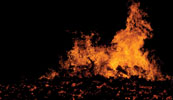

Tackling a fire with the wrong type of fire extinguisher can be ineffective and even dangerous. So says Stephen Mundy, managing director of Chubb Security Southern Africa.
Mundy says it therefore important to analyse all fire risks so that the most effective fire fighting appliance can be selected and sited in the correct position to deal with each hazard.
Nearly all fires develop slowly at first and can be extinguished before serious damage is done if suitable fire fighting equipment is at hand. Even a fire which flares up instantly can be checked to the point of outbreak by prompt action. Portable fire extinguishers provide the means for a rapid response, but if an appliance has to be brought some distance to the fire, the smallest outbreak can extend beyond its capability.
It is also important to remember that the discharge of a portable appliance is limited, as its weight must be kept low for quick and easy handling. The correct siting of portable fire extinguishers and knowledge of their uses, are fundamental to tackling fires effectively.
Extinguishers should be conspicuous and readily accessible, and portable extinguishers should be near exits, mounted on brackets at an approved height. Extinguishers should be marked with easily understood written and pictorial instructions in compliance with SABS regulations, as not all types are operated in the same way. Pictorial signage identifying the position of the fire appliances is absolutely essential. This should conform to the SABS specification.
Extinguishers must also be properly serviced and maintained annually in accordance with SANS 1475 Part 1-2005. Every business should have the peace of mind of knowing that it complies with SANS 10105, SABS 0400 and the Occupational Health and Safety Act with regard to quantity required and type of equipment in the workplace.
Fire in the workplace can be caused by a number of factors. It is therefore essential to recognise the different types of fires and know that not all fires are to be treated the same. After all, the correct treatment for one may prove disastrously wrong for another.
Classification of fires
Class A
Freely burning fires, fuelled by ordinary combustible materials such as cloth, wood and paper. Furniture, waste paper baskets, stationery stores, cleaners' rooms and waste disposal units are among the main danger areas. Cooling by water or spray foam are the most effective ways of extinguishing this type of fire.
Class B
Fires fuelled by flammable liquids and gases such as oils, spirits, petrol, greases, fats, propane, butane and liquid petroleum gas (LPG) or acetylene. Tackling with foam, carbon dioxide (CO2) or dry powder are the most effective ways of extinguishing this type of fire.
Class C
These are fires in the presence of a live electrical current. It is imperative that the power supply is disconnected. Fires involving electrical risks can then be dealt with according to the classification it falls into the above. When the power cannot be isolated and there is a risk of electrical shock, non-conductive extinguishing agents, such as dry powder or CO2 can be used. Ventilating systems, computer rooms, control rooms, switch gear and lift motor rooms are among the main danger areas.
Class D
None of the extinguishing agents referred to above will deal effectively with a fire involving metals. These fires should be dealt with using special extinguishers by personnel trained in the handling of combustible metals for example, aluminium, magnesium, sodium and potassium.
Vehicle fires
Dry powder is the most effective way of extinguishing vehicle fires.
For more information contact Stephen Mundy, Chubb Southern Africa, +27 (0)11 761 7000.

© Technews Publishing (Pty) Ltd. | All Rights Reserved.